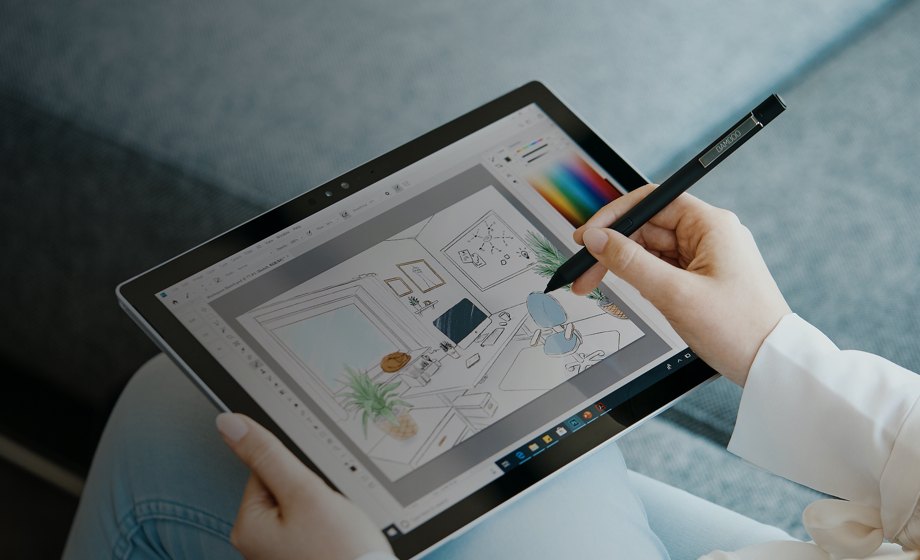Графические планшеты
Делайте наброски, рисуйте и редактируйте изображения с помощью высокочувствительного блокнота и точного пера и наблюдайте за своими работами на экране.


Соблюдение приведенных ниже основных принципов редактирования фотографий поможет Вам уверенно редактировать свои работы. О чем бы ни шла речь, будь то обучение правильному кадрированию или понимание важности того, как и когда ретушировать фото, – следование этим правилам позволит достичь более четкого и детализированного результата без утраты качества.

Важно сделать копию изображения, над которым Вы собираетесь работать: во-первых, в качестве резервной копии, а во-вторых, чтобы иметь возможность вернуться и поработать над изображением заново, если выполненные редакции не понравятся или захочется попробовать совершенно другой подход. Если работа выполняется с помощью программного обеспечения для редактирования фотоизображений, столь же важно использовать при редактировании слои, оставляя при этом основное изображение нетронутым. Таким образом, под рукой всегда будет легко и быстро доступная точка отсчета, позволяющая видеть, как выглядел оригинал, прежде чем производилась подгонка цветов, ретуширование отдельных областей и игра контрастом.
Обрезка, или кадрирование, – один из самых простых инструментов редактирования фотографий, предлагаемых в программном обеспечении, и в то же время один из самых мощных. Если научиться правильно его использовать, то можно успешно избавляться от тех частей изображения, которые не значимы для художественного высказывания, и подчеркивать те части, которые значимы. Применение этого инструмента может предполагать отбрасывание больших фоновых площадей на портретах или фотографиях дикой природы либо использование определенных размеров и соотношений сторон, чтобы снимок выглядел тщательно отредактированным. Соотношение 6:5 хорошо работает с изображением размером в 600 пикселей по горизонтали. Замечательной альтернативой являются квадратные кадры.

Наверное, это прозвучит банально, но – очень важно сохранять одинаковое соотношение величин при изменении размера или масштабировании изображения. Это значит, что соотношения ширины и высоты должны оставаться неизменными, чтобы сохранить перспективу и предотвратить искривление или растяжение изображения. Увеличение изображений более чем на 100 процентов приводит к их пикселизации, хотя можно изменить размер изображения и без потери качества, если прибегнуть к повторной выборке. При этом изменяется количество пикселей в изображении. Чтобы изменить качество конечного изображения, можно также изменить разрешение в рамках программного обеспечения для редактирования фотографий. Например, веб-изображения, как правило, имеют более низкое разрешение, чем изображения в печатном качестве.

Изучение ретуширования кожи и других аспектов изображения является одной из самых увлекательных частей редактирования фотографий. Овладение базовыми инструментами точечного восстановления и клонирования при редактировании фотографий поможет быстро очищать изображения и делать их намного более аккуратными. Однако такие функции следует использовать с осторожностью. Чрезмерное применение техник ретуширования на портретах может быстро сделать объекты нереалистичными, а чрезмерное клонирование может сделать пейзажи неправдоподобными, что нежелательно, если Вы стремитесь сохранить естественный вид. Это правило распространяется также на цвет и насыщенность. «Переборщите» с ними – и изображение будет выглядеть слишком отредактированным, а значит – придется вернуться к оригиналу и начать заново.
Стоит отметить, что все графические планшеты Wacom обладают чувствительностью к нажатию, а это значит, что у редактора есть больше возможностей для управления свойствами штриха – шириной, непрозрачностью и интенсивностью.
Обеспечение идеальной контрастности изображения должно быть приоритетом у любого фоторедактора. Но использование основных инструментов редактирования фотоизображений для улучшения конкретной фотографии часто может приводить к тому, что темные области будут выглядеть слишком темными, а светлые области – размытыми. Чтобы избежать этого, научитесь использовать уровни и кривые, которые содержатся в программном обеспечении для редактирования фотоизображений. Это предоставит Вам гораздо высший уровень управления контрастностью изображения, поскольку позволит исправить определенные области и установить тени и средние тона по своему усмотрению. Освоение этих функций быстро сделает Ваши фотографии по-настоящему выдающимися.

Освоение приемов калибровки монитора для редактирования является важной частью плана по выводу Ваших навыков работы с фотографией на новый уровень. Калибровку можно произвести либо на собственном компьютере, либо с помощью специальных аппаратных средств, которые оценивают Ваш экран, чтобы гарантировать: цвета, которые Вы видите на своем мониторе, совершенно точны. Это значит, что у Вас не возникнет проблема с несоответствием цветов, которое обнаружится только после того, как изображения уже отпечатаны.
Wacom Intuos Pro – идеальный компаньон для того, чтобы усовершенствовать редактирование фотографий. Этот элегантный планшет поставляется со сверхчувствительным пером Wacom Pro Pen 2, позволяющим оттачивать мельчайшие детали изображений. Созданный из материалов исключительно высокого качества и тщательно протестированный на соответствие профессиональным стандартам Wacom Intuos Pro – это верный шаг к совершенству в сфере редактирования фотографий.
Рекомендуемый продукт

Wacom Intuos Pro
Делайте наброски, рисуйте и редактируйте изображения с помощью высокочувствительного блокнота и точного пера и наблюдайте за своими работами на экране.

Делайте наброски, рисуйте и редактируйте изображения с помощью высокочувствительного блокнота и точного пера и наблюдайте за своими работами на экране.

Рисуйте, занимайтесь дизайном и творите прямо на экране с высоким разрешением при помощи точного пера.

Пишите пером по бумаге и конвертируйте свои рукописные заметки в цифровой формат.

Ведите записи и быстро фиксируйте идеи на своем мобильном устройстве при помощи стилуса Wacom.
Wacom ставит своей глобальной целью сближение людей и технологий с помощью естественного интерфейса. Эта концепция сделала компанию ведущим мировым производителем интерактивных графических планшетов и интерактивных дисплеев, а также цифровых стилусов и решений для сохранения и обработки цифровых подписей. Высокие технологии, которые легли в основу интуитивных устройств ввода Wacom, используются для создания превосходных работ цифрового искусства, фильмов, спецэффектов, разработок в области моды и дизайна по всему миру, а также позволяют индивидуальным и корпоративным пользователям выразить свою индивидуальность с помощью одной из лучших технологий интерфейсов. Компания Wacom, основанная в 1983 году, является международной компанией с головным офисом в Японии (Токийская фондовая биржа 6727) и имеет дочерние и аффилированные компании по всему миру, которые занимаются маркетингом и продажами более чем в 150 странах.